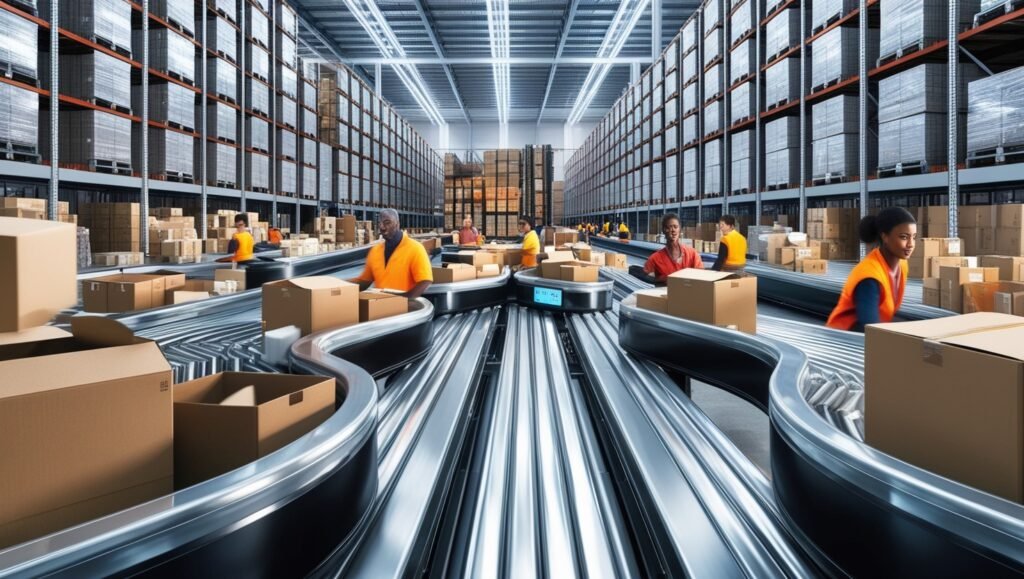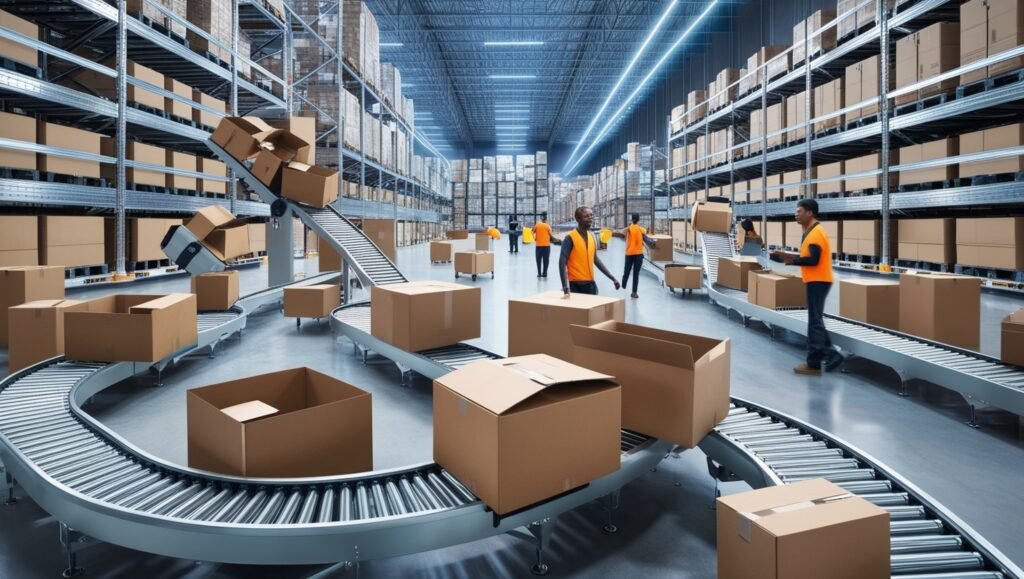- Introduction
- What is Sorter Process?
- Function of Sorter Process
- Benefits of the Sorter Process
- Challenges of the Sorter Process
- Conclusion
- Frequently Asked Questions
- Advantages
- How does the sorter process increase efficiency?
- What cost savings can be expected from implementing a sorter process?
- What maintenance is required for sorter systems?
- How can businesses justify a higher initial investment in a sorter system?
- Can the sorter system handle all types of items?
- Training
- What training do employees need to operate the sorter system?
- Are there any alternatives to sorter systems for small businesses?
- How do sorter systems integrate with existing warehouse management systems?
Introduction
In the fast-paced world of modern logistics, efficient warehousing operations are crucial to meet customer demands and maintain a competitive edge. One of the key components of an effective warehouse management system is the sorter process.
This blog will discuss in depth the functioning of the sorter process, its benefits, and the challenges it presents in warehousing.

What is Sorter Process?
The sorter process involves automated or semi-automated systems of sorting items within a warehouse and directing them to their designated locations.
These systems are designed to handle high volumes of products, ensuring that items are sorted accurately and quickly for storage, picking, packing, or shipping. Sorter systems can vary in complexity, from simple conveyor belts to sophisticated automated guided vehicles (AGVs) and robotic arms.
Function of Sorter Process
Receiving: When items arrive at the warehouse, they are first scanned and identified. This information is fed into the warehouse management system (WMS), which tracks the items throughout their journey in the warehouse.
Induction: The items are placed on the sorter system at the induction point. This can be done manually or automatically, depending on the level of automation in the warehouse.
Sorting: The sorter system, guided by the WMS, sorts the items based on predefined criteria such as destination, item type or priority. Various technologies are used in this step, including barcode scanners, RFID tags and computer vision systems.
Routing: Once sorted, the items are directed to their designated locations. This can be a specific storage area, a picking station or directly to the packing and shipping area.
Dispatching: The sorted items are then prepared for the next step of their journey, whether it is storage or shipping. The WMS ensures that the items are accurately tracked and delivered to their final destination.

Benefits of the Sorter Process
Increased efficiency: Automated sorting systems can handle large volumes of items with high speed and accuracy, significantly reducing the time required for sorting and routing.
Accuracy: Automation reduces human error, ensuring that items are sorted and routed correctly, which is critical for maintaining inventory accuracy and meeting customer expectations.
Scalability: Sorter systems can be scaled to handle increased volumes, making them ideal for growing businesses that need to expand their warehousing operations.
Cost savings: While the initial investment in an automated sorting system may be high, the long-term cost savings from increased efficiency, reduced labor costs, and minimal errors can be substantial.
Improved space utilization: Efficient sorting and routing enables warehouse space to be better utilized, reducing congestion and optimizing storage capacity.
Challenges of the Sorter Process
High initial investment: The cost of implementing advanced sorter systems can be prohibitive for small and medium-sized businesses. ROI must be carefully assessed to justify the investment.
Complexity: Integrating sorter systems with existing warehouse management systems and processes can be complex and requires significant technical expertise.
Maintenance and downtime: Automated systems require regular maintenance to ensure optimal performance. Downtime due to maintenance or malfunctions can disrupt warehouse operations and impact productivity.
Training: Employees need to be trained to effectively operate and manage automated sorting systems. This can be time-consuming and may require ongoing training as technology evolves.
Adaptability: Automated sorter systems can struggle to handle irregular or non-standard items, which can be challenging in warehouses dealing with a wide variety of products.

Conclusion
The sorter process is a critical component of the modern warehouse, offering numerous benefits in terms of efficiency, accuracy, scalability, cost savings, and space utilization. However, it also presents challenges, particularly in terms of initial investment, complexity, maintenance, training and adaptability.
Businesses must carefully consider these factors when implementing sorter systems to ensure they achieve the desired benefits and maintain a competitive edge in the dynamic world of logistics.
Frequently Asked Questions
Process
What is the sorter process in warehousing?
The sorter process in warehousing refers to an automated or semi-automated system used to sort items within a warehouse and direct them to their designated locations. These systems handle large volumes of products, ensuring accurate and efficient sorting for storage, picking, packing or shipping.
How does the sorter process work?
Receiving: Items are scanned and identified upon arrival.
Induction: Items are placed on the sorter system at the induction point.
Sorting: The system sorts items based on criteria such as destination, type or priority using technologies such as barcode scanners and RFID tags.
Routing: Sorted items are directed to specific locations, such as storage areas or packing stations.
Dispatch: Items are prepared for storage or shipping.
What technologies are used in sorter systems?
Sorter systems use a variety of technologies, including:
Conveyor belts
Barcode scanners
RFID tags
Automated guided vehicles (AGVs)
Robotic arms
Computer vision systems
Benefits
What are the benefits of a sorter process in warehousing?
Increased efficiency: Handles large volumes of items quickly and accurately.
Accuracy: Minimizes human error, ensuring correct sorting and routing.
Scalability: Can be scaled to handle increased volumes, which supports business growth.
Cost savings: Long-term savings from increased efficiency and reduced labor costs.
Improved space utilization: Optimizes storage capacity and reduces congestion.
challenges
What are the challenges associated with a sorter process?
High initial investment: Significant upfront costs for advanced systems.
Complexity: Integration with existing systems can be complex.
Maintenance and downtime: Requires regular maintenance and may experience downtime.
Training: Employees require training to operate and manage the system.
Adaptability: Can struggle with irregular or non-standard items.
Advantages
How does the sorter process increase efficiency?
Automated sorter systems handle items with high speed and pinpoint accuracy, significantly reducing the time needed for sorting and routing. This efficiency improves overall warehouse operations, leading to faster order fulfillment and better customer satisfaction.
What cost savings can be expected from implementing a sorter process?
While the initial investment is high, long-term cost savings come from increased operational efficiency, reduced labor costs, and minimal errors. These savings can be substantial, making the investment worthwhile over time.
What maintenance is required for sorter systems?
Sorter systems require regular maintenance to ensure optimal performance. This includes checking mechanical components, updating software, and addressing any wear and tear. Regular maintenance helps prevent unexpected downtime and increases the system’s lifespan.
How can businesses justify a higher initial investment in a sorter system?
Businesses can justify the investment by estimating long-term benefits, such as increased efficiency, cost savings, scalability, and improved space utilization. A detailed ROI analysis can help determine the financial viability of implementing a sorter system.
Can the sorter system handle all types of items?
Sorter systems are designed to handle a wide variety of items, but they may struggle with irregular or non-standard items. Businesses dealing with diverse products should consider this factor and possibly implement additional solutions to handle such items effectively.
Training
What training do employees need to operate the sorter system?
Employees need extensive training to operate and manage the sorter system. This includes understanding the functionality of the system, troubleshooting common problems, and maintaining the equipment. As technology evolves and new features are introduced, ongoing training may be necessary.
Are there any alternatives to sorter systems for small businesses?
Small businesses with low volumes may opt for semi-automated or manual sorting processes. While these options are less efficient than fully automated systems, they require less initial investment and may be more manageable for businesses with limited resources.
How do sorter systems integrate with existing warehouse management systems?
Sorter systems integrate with warehouse management systems (WMS) through a software interface that allows data exchange. This integration ensures that sorting and routing processes are aligned with inventory management, order processing, and other warehouse operations.
